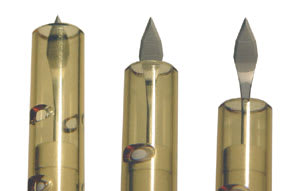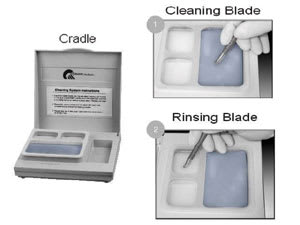feature
Surgical Blade Safety
Cataract surgeons discuss their concerns and
how they address safety issues.
BY
JOHN PARKINSON, ASSOCIATE EDITOR
The Centers for Disease Control and Prevention estimates that between 600,000 and 800,000 needlesticks and other percutaneous injuries occur among healthcare workers annually. When a surgeon considers the gravity of contracting HIV or hepatitis B or C due to an accidental knife or blade stick, the importance of instrument safety takes on a more serious, life-threatening tone. While those diseases are extreme examples, ophthalmologists, nevertheless, have to remain disciplined about blade safety to protect themselves, their staffs, and their patients.
This article will discuss some of today's blade safety issues with surgeons, and they will offer insights into their strategies for dealing with these issues.
Metal Blades, Diamond Blades
|
|
|
Diamatrix Ltd's Sharps Safety Knife features a patented handle design. The company offers safety blades in metal. |
The shared wisdom within the ophthalmic community is that diamond blades can deliver sharper incisions than metal blades. Surgeons interviewed for this article all felt sharper incisions provide safer and better phaco outcomes for patients when utilizing clear corneal incisions.
After trying several different types of blades, Ralph Chu, M.D., has gone to diamonds for his phaco procedures and subscribes in the safer, better results theory. "I think the blade has to be consistently sharp; you have to know you are going to get a clean incision of the appropriate size and architecture every time to ensure a stable, solid non leaking wound. Diamonds give you that consistency."
Barry Seibel, M.D., concurs and sees the protection of diamond blades as a significant aspect to keeping the knives' consistency. "If the blade is compromised at all, if it touches anything and has a microscopic nick, it loses that sharpness," explains Dr. Seibel. "You end up pushing more and distorting tissue, and not giving as safe an incision." Dr. Seibel says a less than precise, sharp knife edge affects wound integrity.
"Diamond blades come standard on our retractables and this continues to be an important safety feature over metal," says John Bee, president of Tampa-based Rhein Medical.
For sterilized metal blades, the largest single safety advantage is that they are indicated for single usage. If followed as indicated, single usage takes away the potential for passing infection or disease to other patients.
Overall, economics play an important role in what knife a surgeon chooses, as there is a large cost differential between diamond and metal blades. Charles Williamson, M.D., uses Diamatrix sharp safety diamond and metal blades. However, he does understand why a surgeon may opt to use metal exclusively. "Sometimes, for surgeons who are not doing a high volume, it probably would be more cost-effective to use the metal blades."
Settings can also dictate what blades surgeons use. Francis S. Mah, M.D., works in a big university hospital, and he has gone to metal blades in place of diamonds.
"My scrub nurses and my techs will vary from day to day. Some of these people may have gone from an orthopedic procedure, and now they are helping me to do a cataract procedure," says Dr. Mah. "We have had multiple incidents where we have had diamond blades broken without them being used once. Although it is clear diamond blades are sharper and offer a reproducible incision, metal blades have improved immensely such that the difference between sharpness and reproducibility has been minimized."
Maintenance and Cleaning
Maintaining sterile instruments is paramount in trying to avoid the introduction of an outside infection into the eye, and having a reliable staff that can handle diamonds is key. "Diamonds can be hard to clean and maintain if you don't have consistent staff at your facility," acknowledges Dr. Chu.
|
|
|
The Rhein Reusable Knife Cleaning Cradle with cleaning pack utilizes a system that keeps hands away from the blade. |
One of Dr. Seibel's assistants uses a unique "no touch" technique to clean diamonds. The assistant takes a 20 cc syringe, fills it with balanced salt solutions (BSS) and pushes a jet stream of BSS onto the knife. The assistant will then autoclave the instrument.
When there is excessive friction during the incision, Dr. Seibel may determine the instrument should be sterilized using ultrasound. In an effort to protect the overall integrity of the blade, his assistant will suspend the knife handle while the diamond is in the ultrasound being sterilized.
Rhein Medical has developed a new knife cleaning cradle system and cleaning well. "We have tried to focus on cleaning the diamond blade away from the hands, as it can be a dangerous operation," explains Bee.
Malvern, Pa.-based Accutome, a company that sells metal and diamond blades, provides instructions on how to clean diamond knives. The company recommends the following steps:
►After surgery, rinse lower 1/4 of knife. Do this under tepid water for 1 minute with the blade exposed. Do not use heavy water pressure; a small stream of water is best. Point front of knife down when flushing.
►Hold the knife in a fully retracted position in the ultrasound. Do this until the bath is filled with distilled water and three or four tablets for 2 to 3 minutes. Do not place the entire knife in the cleaner as protein in the solution will eventually jam the internal mechanism.
►If the diamond is not clean repeat step one. It is important not to wipe the diamond with any product. Rather, continue to soak it in the ultrasound cleaner for an extended period of time.
►The blade must be in the retracted position when sterilizing. An acceptable method is 275Þ F maximum temperature for 3 minutes unwrapped to 30 minutes wrapped.
OSHA and Congress
For those ophthalmologists who are employers, there are federal standards in place on how to handle sharp instruments. The Occupational Safety & Health Administration (OSHA) issued the Bloodborne Pathogens Standard to protect workers at risk back in the early 1990s. In 2000, Congress passed the Needlestick Safety and Prevention Act. The following year, OSHA, in response to the Act, revised its first Bloodborne Pathogens standard to include employers.
This last OSHA standard states that employers need to select safer medical devices; to involve employees in identifying and choosing these devices; review and update yearly their blood pathogen plan and use of safety devices; and maintain a log of injuries from contaminated sharps. Private practices are exempt from this log requirement. To learn more about the OSHA standard, go to www.osha.gov, and search for bloodborne pathogens and needlestick prevention on the site.
Dr. Williamson acknowledges
OSHA's compliance rules have influenced his blade safety protocols. While he says
the government has given the industry a "grace period" to catch up to the federal
standards, he does see more governmental enforcement in the future. "We are going
to see more
regulation and oversight regarding blade safety," predicts Dr. Williamson.
Knife Stick Prevention
As intraoperative knife handling is where many injuries occur, some surgeons believe instrument technologies and personnel strategies can cut down on these incidents. Diamond blades have the added safety feature of retractability; nevertheless, there are still chances an injury can occur even with this safety feature being used, especially if communication is lacking between the surgeon and support staff.
Communication can be difficult if doctors work with numerous surgical nurses. Conversely, if a surgeon works in a smaller ASC with a consistent small subset of people on a regular basis, communication about blade handling can be understood and complied with when everyone is on the same page. "With a smaller group of people, you can and should establish safety protocols," says Dr. Seibel.
|
|
|
The BD Beaver Xstar Safety Slit Knife has an integrated safety shield. |
A New Concern?
Becton, Dickinson and Company (BD), based in Franklin Lakes, N.J., held two roundtables — one in the United States and the other held in Europe — in the fall of 2004 to talk about the emerging safety issues in ophthalmic surgery. One of the big topics of discussion was Creutzfeldt-Jakob Disease (CDJ).
While this disease has been seen primarily as something of a European issue in the past, especially the bovine spongiform encephalopathy form (mad cow disease), the disease is much more pervasive than originally thought.
The U.S. roundtable was moderated by Randall Olson, M.D., with Henry Perry, M.D., and Dr. Mah participating in the discussions.
"Because prions have unique characteristics — extreme infectivity, virtual indestructibility and the prolonged, asymptomatic latency period, there is an increased risk that contaminated instrumentation could infect other healthy patients and/or members of the healthcare team who experience a sharps injury," wrote members of the roundtable.
Except for the variant form of CJD, the disease's latency period evolves into an active disease when a person reaches their 50s and/or older, according to Dr. Mah. Possibly the most troubling aspect of CJD is that it has a history in ophthalmology. "The critical reason it is an ophthalmic concern is that besides CNS neural tissue, eye surgery is the only other documented method of transmission," says Dr. Mah.
Even when a person becomes afflicted with an active case of CJD, explains Dr. Mah, a confirmation of CJD can be done only by completing a brain biopsy. The University of Pittsburgh, where Dr. Mah works, put in special CJD protocols a couple of years ago after national reports about CJD problems at medical facilities surfaced.
"Every eye surgery patient, since it has been documented that CJD can be transmitted through eye surgeries, are asked a couple of questions," explains Dr. Mah. All patients are asked if they have ever been to Canada or Europe. If they have been, says Dr. Mah, they are labeled as high-risk CJD candidates and put at the end of the surgical schedule — which creates its own set of individual challenges. One of those challenges is cleaning instruments to rid of potential CJD. "It's been recommended these instruments be cleaned for an hour at 250Þ in a gravity displacement cycle, or soaked in sodium hydroxide for an hour," says Dr. Mah.
Nonetheless, Dr. Mah says CJD threats to surgeons, staff and patients can be prevented. "It may not be the first thing on your list [CJD], but if you are treating everybody as if they have some bloodborne pathogen and use universal precautions, that is much safer than trying to identify an individual disease," says Dr. Mah. "Invariably, there will be some other disease that will come that we weren't prepared for."
Good Policy, Staying Informed
Adopting prudent instrument handling and cleaning protocols, utilizing blade safety technologies and keeping current with the latest issues can keep everyone who comes into contact with knives or blades out of harm's way.











